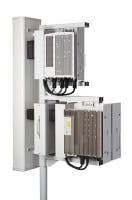CommScope simplifies base station antenna, RRU interface for easier cell tower upgrades
Expanding on its Andrew SiteRise platform, CommScope (NASDAQ: COMM) has launched a new product aimed at reducing installation and maintenance cost, risk and time at the top of cellular network towers. The new Andrew SiteRise Standard Interface is intended to simplify the interface between the base station antenna and virtually any remote radio unit (RRU) technology. CommScope bills the SiteRise Standard Interface as a new way of connecting an RRU to the base station antenna, using a unique approach not previously utilized for tower-top applications.
The SiteRise Standard Interface gives an operator the flexibility of using multiple RRU technologies and frequency bands in a simplified plug-and-play arrangement. Key to this solution is a patented new connector technology that provides an essentially passive intermodulation (PIM)-free, blind mate connection. (PIM is a major concern with today’s interference-limited technologies such as LTE, notes the company.) With blind mate connection capability, upgrading and maintaining radio technology can be done without affecting the antenna’s position. This functionality reduces the time and cost associated with radio maintenance, and, even more importantly, reduces the risks associated with technology obsolescence.
“The top of the tower is a difficult place to work, so having a solution that provides for a more consistent and predictable quality result, and provides flexibility for change just makes sense,” comments Morgan Kurk, senior vice president, wireless, for CommScope. “We are ready to work with all major radio and antenna OEMs to make this technology broadly available to the benefit of networks everywhere.”
According to the company, SiteRise Standard Interface offers lower risk and higher quality assurance by moving the complex connecting work at the top of the tower into a more controlled environment. This innovation reduces the risk of craft-related errors due to the harsher and more complex working conditions at the top of the tower. The easy accessibility enabled by SiteRise Standard Interface makes upgrading RRUs for changing frequency and technology requirements a plug-and-play feature, contends CommScope.
Related: CommScope offers turnkey FTTA cabling plus RRU connectivity
Combining multiple frequencies is also common in today’s cell sites. The SiteRise Standard Interface includes an optional filter integration that reduces potential sources of interference and the need for more complex solutions internal to the RRU technology. Ultimately, the company expects the SiteRise Standard Interface to reduce the time installers spend working on the tower, saving operating costs and creating faster site turn ups, critical for operators’ time-to-market competitive advantage.
“Since we began implementing the SiteRise solution in close collaboration with a major wireless operator, we have continued to work closely with the whole operator community to understand what innovations would be of additional value to them,” says Ben Cardwell, senior vice president, global wireless sales, CommScope. “Those conversations led to a new SiteRise solution aimed at even greater simplification of the radio and antenna interface, which provides for even less interference risk, better flexibility and a true plug-and-play capability at the top of the tower.”
Unveiled in 2013, the Andrew SiteRise system is a pre-assembled tower-top platform designed to bring factory-assembled quality and consistency to the field assembly environment of a wireless network cell site. Andrew SiteRise facilitates the rapid implementation of RRU technology in close physical proximity to the antenna connectors, reducing losses and improving network performance. The SiteRise platform already is proving cost-effective for operators by moving the complex connection, configuration and testing work from the top of the tower to ground level where it can be done in a controlled environment.
“Our antenna/RRU SiteRise Standard Interface combines the best features of putting remote radios close to the antenna for reducing signal loss and energy consumption, but maintains a level of independence between the radio and antenna for flexibility and ease of support,” adds Cardwell.
Significantly, as part of its evolution of solutions at the top of the tower, CommScope is also introducing new approaches for fiber cable connectivity and protection. Available now, the Heliax FiberFeed Direct cabling solution can enable quicker installations by mating hybrid fiber and power cable to any RRU model, reducing the number of overall connections and cutting installation time by half. Additionally, complementing CommScope’s Heliax line of RF cable assembly solutions, the new Heliax SureGuard weather protection system is billed as an easy-to-install solution that can weatherproof up to 10 antenna connectors in minutes while requiring no special tooling and being reusable.
The latest iterations of CommScope’s Andrew SiteRise system will be introduced at Mobile World Congress, February 24–27, in Barcelona, Spain.
Related resource: Quick-start guide to FTTA

